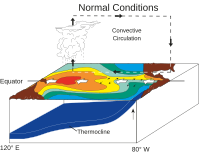
Photo from wikipedia
This study investigates the linear and nonlinear dynamics of precipitation and temperature extremes. Monthly daily temperature range (DTR) and maximum 5-day precipitation (RX5) data for sixty three years were obtained… Click to show full abstract
This study investigates the linear and nonlinear dynamics of precipitation and temperature extremes. Monthly daily temperature range (DTR) and maximum 5-day precipitation (RX5) data for sixty three years were obtained from the archives of the Expert Team on Climate Change Detection and Indices (ETCCDI). Spatial maps were constructed for the descriptive statistics (mean, standard deviation, skewness, trend and variance) of both DTR and RX5, as well as nonlinear analysis (entropy, Hurst exponent, determinism and laminarity) for Africa and South America. The research focuses on identifying the unique signature of climate extremes using linear and nonlinear approaches. The deserts of Africa and South America were found to exhibit lower complexity (determinism greater than 0.7) and higher persistence in RX5 values compared to the rest of the continent. The high complexity observed on the African continent were attributed to dynamic atmospheric circulation patterns in the region. The dynamics of equatorial West Africa and Congo River basin were found to be less complex (determinism greater than 0.3) than the rest of the continent when DTR values were analyzed. Using determinism and laminarity (greater than 0.5), the complexity of the Brazilian highlands were observed to be the highest in both DTR and RX5 analysis. Quantitative analysis of climate extremes using nonlinear approaches have been found to be detailed and useful.
Journal Title: Asia-Pacific Journal of Atmospheric Sciences
Year Published: 2019
Link to full text (if available)
Share on Social Media: Sign Up to like & get
recommendations!